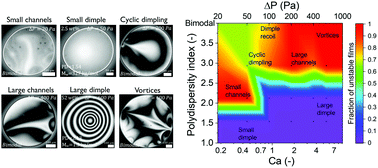Dynamic stabilisation during the drainage of thin film polymer solutions†
Abstract
The drainage and rupture of polymer solutions was investigated using a dynamic thin film balance. The polymeric nature of the dissolved molecules leads to significant resistance to the deformation of the thin liquid films. The influence of concentration, molecular weight, and molecular weight distribution of the dissolved polymer on the lifetime of the films was systematically examined for varying hydrodynamic conditions. Depending on the value of the capillary number and the degree of confinement, different stabilisation mechanisms were observed. For low capillary numbers, the lifetime of the films was the highest for the highly concentrated, narrowly-distributed, low molecular weight polymers. In contrast, at high capillary numbers, the flow-induced concentration differences in the film resulted in lateral osmotic stresses, which caused a dynamic stabilisation of the films and the dependency on molecular weight distribution in particular becomes important. Phenomena such as cyclic dimple formation, vortices, and dimple recoil were observed, the occurrence of which depended on the relative magnitude of the lateral osmotic and the hydrodynamic stresses. The factors which lead to enhanced lifetime of the films as a consequence of these flow instabilities can be used to either stabilise foams or, conversely, prevent foam formation.



 Please wait while we load your content...
Please wait while we load your content...